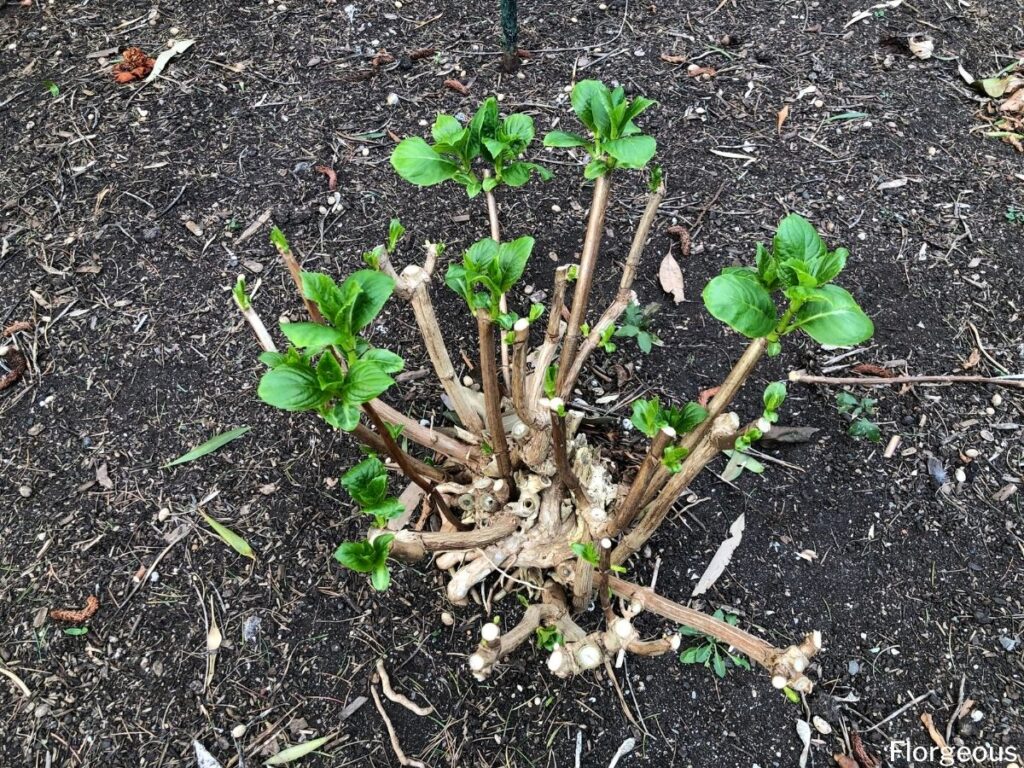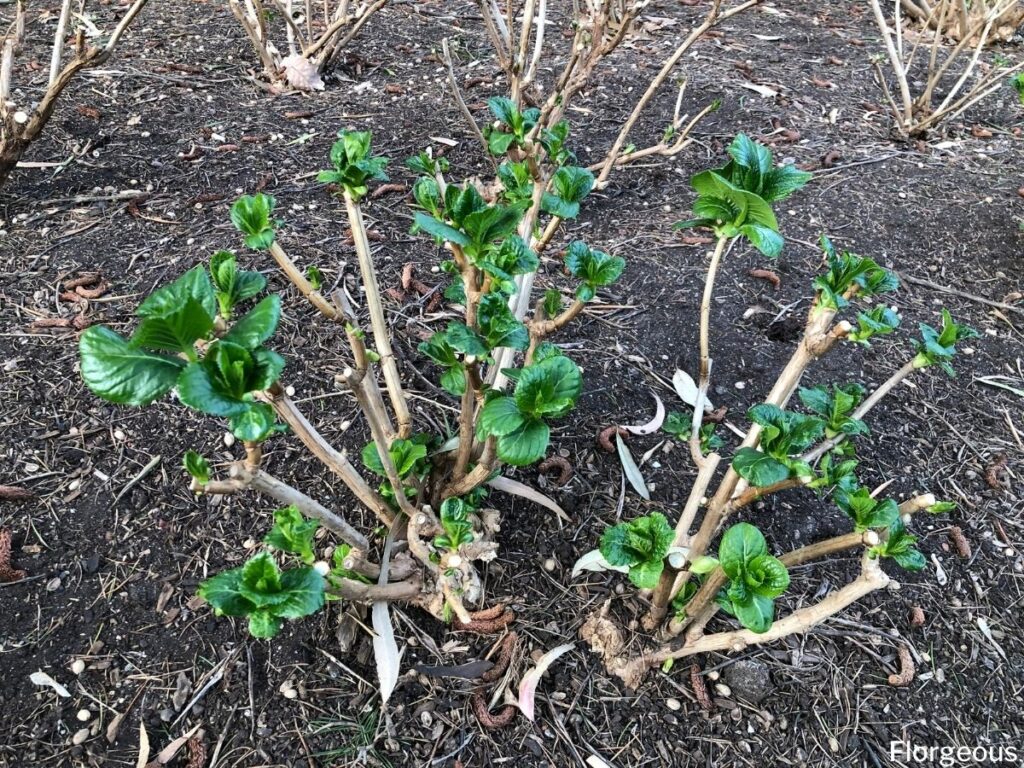Are you interested in learning how to propagate hydrangea bushes?
Hydrangea propagation isn’t necessarily challenging, but there are a few specific steps you will need to follow in order to be successful.
Here’s what you need to know.
How Do You Grow Hydrangeas From Cuttings?
There are a few different ways you can propagate hydrangea shrubs, including rooting new cuttings and ground layering. You can also root cuttings in water, though this is not the most popular option (we’ll tell you more about this at the end of the article).
Method 1: Rooting Cuttings
Start by cutting a branch from your mature hydrangea plant. It should be around five or six inches long. Ideally, you should take a hydrangea cutting from one of your branches that failed to flower this year. These tend to root the best.
Remove the bottom leaves of the lower pair of leaf nodes. If you aren’t sure what a leaf node is, it is simply where the leaf comes out of a branch. This is where roots are most likely to form.
Cut the largest leaves to half their size, then dip the cuttings in a small amount of rooting hormone and put into sterile potting medium or vermiculite.
Water the container well, then allow it to drain. It’s important that you ensure that the potting mix is moist, though not soggy, then cover the container with plastic. Add a couple of stakes to prevent the plastic from coming into direct contact with the cutting.
Put your cuttings in an allocation that receives indirect light – but is out of direct, bright light. It is important that you do not put the cuttings directly in sunlight when they’re covered in plastic, as they will get too hot and dry beneath the plastic.
You shouldn’t need to water again until the top of the soil is dry to the touch. Overwatering can cause the cuttings to rot. Your cuttings should develop new roots in just a couple of weeks, sometimes longer, depending on the humidity and temperature. Those propagated in warm, humid weather will make new plants grow much more quickly.
You’ll know that your cutting has developed roots once it resists your pull when you tug on it.
Method 2: Ground Layering
Ground layering is another simple method. You can only root a couple of hydrangea plants at once unless you already have a lot of hydrangeas growing in your garden.
To do this, all you need to do is select a parent plant that you have already grown in your garden. Take a branch that is growing close to the ground, then snip the leaves at about six inches.
Do this in the location where the dipping branch comes into contact with the ground when you tug it down (be gentle doing this so you don’t break the plant). Scrub off some of the bark on the underside of the stem, then make sure that at least one of the leaf nodes will be fully underground.
Avoid cutting or snapping this branch of the original plant, but dig a small trench that’s two inches or so in depth and then lower the branch into it. Cover it with soil and then put a stone or brick on the burned area so it remains in the ground.
This will help the branch stay under the soil and keep water (but not pooling water) around the branch. Keep your hydrangea plant watered regularly – this will encourage root development at the base of the cutting. Once root systems are well-established, typically in a few weeks, you can trim the branch from the original plant and put it in a new location in the garden.

Method 3: Stem Cuttings
Propagating hydrangeas by stem cuttings is a simple and effective method to grow new plants.
Begin by selecting a healthy stem with several leaves and no flower buds. Cut the stem at a 45-degree angle just below a leaf node. Remove the lower leaves, leaving a few at the top.
Dip the cut end in rooting hormone powder to enhance root development. Plant the cutting in a container filled with moist potting mix, ensuring the soil stays consistently damp. Cover with a plastic bag or dome to maintain humidity, and keep in a warm, indirect light environment.
With patience, roots will form within a few weeks, leading to a thriving new hydrangea plant.
When Should You Take Hydrangea Cuttings?
The perfect time to take cuttings is between the late spring and early fall. You should not wait until it’s too cold outside because this may cause problems with rooting your plants indoors before they have a chance to grow roots in their new location.
Otherwise, several cuttings might fail – it’s hard to keep young plants healthy when you have them indoors during the winter.
Ideally, you’ll need to plan for about six to eight weeks for your cuttings to fully form before you can plant them in the garden.
Can You Root Hydrangea Cuttings in Water?
Water propagation is a technique that has become very popular of late, with people propagating their own celery plants, avocado trees – and yes, hydrangeas! – in just a bit of water.
It isn’t necessarily the best method for rooting hydrangeas, since they don’t love being overly wet. Plus, propagating hydrangeas in water can cause them to develop weaker root systems, which won’t always be successful when you transplant them to the soil.
That said, there have been people who have been successful with this technique – so feel free to give it a try, but be patient with yourself!
Begin by taking a small plant cutting. Position it in a glass of room temperature water, making sure only the stem comes into contact with the water. The leaves and other parts should not. The glass you use should ideally be clear so that you can check on how the roots are developing.
Every few days, change out the water. Make sure your glass is located in direct sun light (ideally some that is filtered, like in a bedroom windowsill). You can add some liquid rooting hormone to the water when you put the cutting in the jar, but this is optional.
It can take a few weeks for any new growth to appear, but once it does, you can follow the same steps as above for transplanting your new new hydrangea plant.
FAQs
What is the best way to propagate a hydrangea?
The best way to propagate a hydrangea bush is through softwood cuttings. Take cuttings from healthy, non-flowering shoots, typically around 4-6 inches long, and remove the lower leaves. Dip the cut end in rooting hormone and plant it in a well-draining potting mix. Keep the soil moist and provide indirect light while the roots develop.
Will hydrangea cuttings root in water?
Yes, hydrangea cuttings can root in water, but soil propagation is generally more successful. If you choose to root in water, place the cutting in a jar with water covering just the base of the stem. Change the water regularly and watch for root development before transferring the cutting to soil.
When should you take hydrangea cuttings?
The best time to take hydrangea cuttings is in the spring or early summer when the plant is actively growing. Take cuttings from healthy, new growth and avoid woody or older stems.
Do hydrangeas propagate themselves?
No, hydrangeas do not typically propagate themselves through seed as they may not come true to type, but they can spread through layering if the branches touch the ground and form root system. This can be an easy way for hydrangeas to propagate themselves naturally.
Final thoughts
In conclusion, the ability to propagate hydrangeas offers gardeners an opportunity to expand their collections with minimal cost and effort.
With the right techniques and patience, anyone can propagate hydrangeas and enjoy the beauty and variety of these stunning plants in their outdoor spaces for years to come.
If you don’t enjoy hydrangea propagation, growing hydrangea from seed could be a great alternative.







